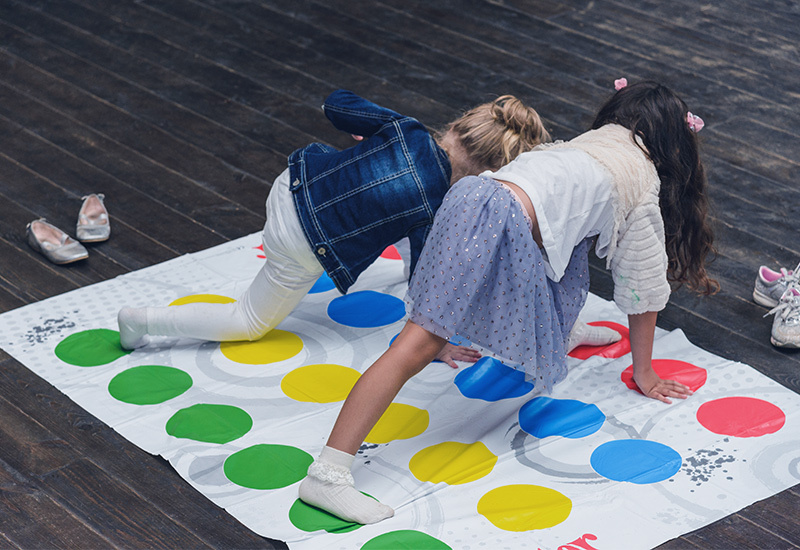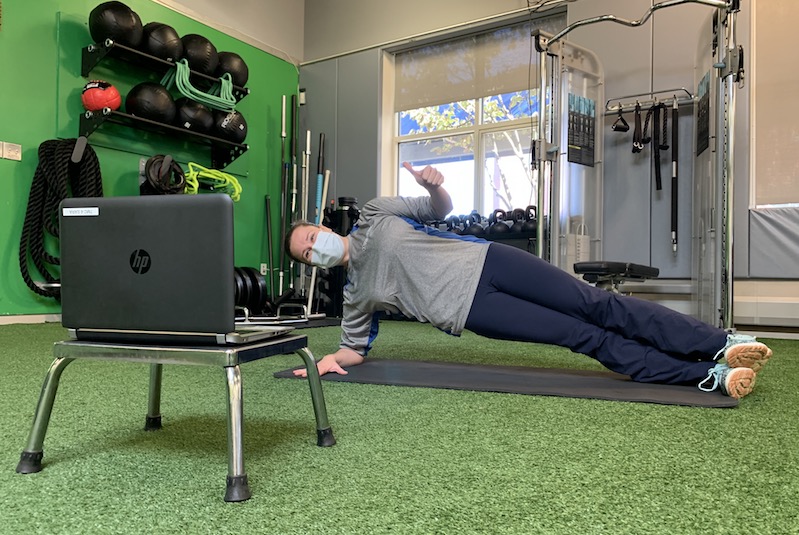Keeping kids active indoors: Top tips from our experts

For many parents, keeping their kids active during the spring and summer months of COVID-19 involved a lot of outdoor time. But with colder temperatures on the way, you might be wondering how to survive the winter months, especially if your kids are doing most of their schooling from home.
For answers we turned to Miguel Gonzalez and Sara Collins, injury prevention specialists at The Micheli Center for Sports Injury Prevention. Here are their suggestions for kids of all ages.
Take mini movement breaks
“When kids are on screens for six or more hours for school, they’re like toast at the end of the day,” says Collins. She suggests taking 5-to 10-minute activity breaks throughout the day. “One fun idea is to write a bunch of different activities — such as jumping jacks, follow the leader, running in place, or doing animal walks — on popsicle sticks or small notecards and then have your kids take turns choosing one.”
Sara demonstrates how to use pillows for a home workout.
1. Bridge with alternating leg extensions
2. Squats
3. Forward lunge (be sure to alternate sides)
4. Bird dog (be sure to alternate sides)
Do a ‘gym’ workout
If you’ve got pre-teens or teens at home, they may be more into doing a more traditional gym workout. This doesn’t mean you need a lot of fancy equipment. “There are lots of exercises kids can do at home with no equipment,” says Gonzalez. “For example, they can do exercises that rely on their own bodyweight, such as squats, pushups, pullups, or sit-ups.”
He says you can also purchase inexpensive exercise equipment like jump ropes or weights. Or, encourage your kids to get creative with items from around the house. Some ideas include:
- make weights of different sizes with plastic bottles or PVC pipe filled with water or sand
- use a backpack filled with books as a weight, adding and removing books as needed
- use a towel to do lunges on a wood floor
- use the edge of a chair for doing dips or squats
Create a circuit workout
Another idea Gonzalez recommends for school-age kids and teens is creating a circuit workout. “Depending on their age, they can do a few sets of different types of exercises that exercise different parts of the body with a 15-30 second break in between rounds.”
Work out with The Micheli Center
The Micheli Center offers individual, semi-private, and group virtual training sessions for kids of all ages. These sessions are great for anyone who want to stay active, learn exercise basics, work on strength or conditioning, or learn injury prevention. Collins also offers a virtual yoga class on Friday afternoons for 8-to 14-year-olds. Visit The Micheli Center to learn more or to register.

For example, school-age kids could do sets of 10 jumps on one foot, 10 bean bag tosses, and 10 squats. Pre-teens and teens might do 15 burpees, 15 jumping jacks, and 15 single leg lifts. Gonzalez says the internet is a great source of information for ideas and videos on how to do these exercises safely.
Turn to YouTube
If your kids need a bit of inspiration for a workout, Collins also suggests turning to the internet. “YouTube is a really valuable resource for this,” she says. “There are a lot of quick, high-intensity interval (HIIT) training videos that run anywhere from 8 to 35 minutes and combine different kinds of exercise to give kids a quick burst of energy.”
With a bit of help from parents, YouTube is also a good source for exercise videos for the younger set. “Kids can even search for a particular kind of workout, like a Ninja routine or balance exercises, if they are interested in certain types of exercise,” says Collins.
Keep up with sports conditioning
For kids who play a sport, they can use this time to keep up with conditioning, even if their team is not practicing or playing. “Sports are all over the map right now, and everyone is doing something different,” says Collins. “But it’s important for athletes to keep up with their general skills, because once sports do start again, they are not likely to ease into it. So the kids will need to be in good condition to avoid getting injured.”
She says to encourage athletes to do whatever they can, whether it’s running, walking, strength training, or stretching. “It may be a good opportunity for them to explore activities they’ve never tried,” says Collins. “I’ve seen that with some of the dancers I worked with, who have started HIIT training or strength training to stay in shape.”
Sara Carpenito, an injury prevention specialist at The Micheli Center, demonstrates some great moves you or your kids can do in your own space using just a towel.
Have a dance party
One easy way to get little ones moving is to put on some music. “Put on some fun music, and most kids just naturally start moving,” says Collins. “Playing music and encouraging kids to jump around can be a great way to quickly uplift the environment in your entire house, especially if you sense your kids have pent-up energy.”
Don’t forget outside time
Unless the weather is really miserable, try to usher your kids outside for at least a few minutes each day. Gonzalez says getting a few minutes of fresh air and sunlight can improve kids’ mood and help them get through the rest of the day, especially if they are spending a lot of time in front of a screen. “Take 5-10 minutes and go out for a walk around your block, grab a ball and dribble, or just let them run around the backyard or local playground or park.”
Let your kids have a say
Gonzalez says it’s important to remember to listen to your kids, and ask what kinds of activities they want to do. “Whatever type of movement your kids can do during the day is great. Try to spend some time being engaged and active with them, and you’ll both feel better.”
Read more about Boston Children’s response to COVID-19.
Related Posts :
-

Questions to ask about your child’s orthopedic care
Maybe your child has an orthopedic injury and needs surgery, or maybe they need to be treated with a different ...
-

Engineered cartilage could turn the tide for patients with osteoarthritis
About one in seven adults live with degenerative joint disease, also known as osteoarthritis (OA). In recent years, as anterior ...
-

My story of bouncing back from osteochondritis dissecans
Injuries suck — no better way of putting it. The physical pain is terrible on its own, but emotionally they can ...
-

Why parents really need to talk to their children about the news
These are strange, anxiety-provoking times. That’s true no matter where one lives or where one sits on the political ...





